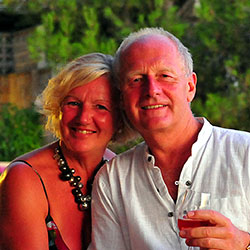The best way to appreciate Stone Town’s history in Zanzibar, is simply to walk the streets.
Although the principal building material of Stone Town is coral, hence its name, the warm-coloured stone has been sculpted by successive occupiers to leave their cultural and architectural signatures throughout.
Zanzibar’s strategic and easily accessible location along the East African coast made it a cosmopolitan melting pot, where Arabs, Indians, Europeans and Africans merged their traditions and cultures.

Arab, Persian, Indian, European, and African traditions are represented in a collection of over 1,500 buildings of various origins and states of current repair.
Due to the friable nature of the coral stone used to build them, it also means that nearly 80% of them are in poor repair, despite Stone Town being a UNESCO World Heritage Site.
Nevertheless a stroll through the narrow streets reveals a tapestry of cultures past. As we enter what seems to be a maze of alleyways filled with the clamour of traders and local people, we wonder if we’ll ever find our way out again.
Our preconception of Stone Town is of an ancient trading port – exotic hub of the Spice Route. However, Zanzibar as a ‘town’ is relatively ‘young’, as although records date back to the 1st century as a fishing village, it was only after the Portuguese settled and laid the foundations of The Old Fort (subsequently completed by the Omani rulers in 1780) that Stone town started to establish itself with largely Arabic occupants and therefore, architecture.
As we thread our way through the busy streets we’re mostly aware of the markets, masses of Swahili people and wares of all descriptions.
In stark contrast to this, the buildings are largely of Arab origin – often square, with spacious inner courtyards to allow light and air to circulate throughout – and built sufficiently close together to provide shade and cooling breezes in the streets; with the ability, historically, to bridge between them at upper levels to allow the passage of female family members without being seen in public.
This is not the mellow muted architecture of Moorish influence but a grander Middle Eastern style that hasn’t weathered well.
The first we’re aware of these buildings is when we pass substantial studded or ornate doors at street level that hint at what they lead to in the towering walls above.
The nature of decoration and door shape can suggest the owner’s culture, with studs and curved tops generally being of India origin, whereas carved bas-relief panels in square doorways suggest Arabic ancestry.

A baraza, or long stone bench, skirts the outside walls of these traditional buildings, useful as an elevated walkway in heavy rains and as a bench to rest upon or socialise.
Large verandas and balconies are protected by intricately carved wooden balustrades.
In the late nineteenth century and early twentieth century the town became clearly divided between Arab, Indian and European neighbourhoods; with very few Africans living here until later, when Swahili influence subsequently prevailed.
Apart from the fascination inherent with any old town in terms of the market traders who now cram the streets with indigenous wares, it’s of ongoing interest to us to forensically pick apart the cultural heritage of each area as we weave our way through the alleyways – playing at identifying the origin of each former inhabitant by virtue of the architectural narrative they’ve introduced or left behind.
Many of these substantial properties were seized by the socialist government after the ‘Zanzibar Revolution’ of 1964 left most of them abandoned; as the Sultan was deposed and ‘colonials’ left in their droves.
What followed was the demise of the town, architecturally, as formerly grand well-maintained properties were turned over as ‘Public Buildings’ to multiple groups of poor families who had neither the income nor inclination to preserve them.
Some of the larger and more prominent buildings have been painstakingly restored and act as reminders of a former elegance and sophistication, sadly now, long gone.

The ‘Palace of Wonders’, or ‘Beit-al-Ajaib’, located on Mizingani Road on the Stone Town seafront, is one of the better known landmarks.
Built in 1883 and restored in 1896 after the Anglo-Zanzibar War, it was formerly the Sultan’s residence and then home to the Afro-Shirazi Party after the 1964 Zanzibar Revolution.
Now a museum of Swahili and Zanzibar culture, it was the first building in Zanzibar to have electricity and in East Africa to have a lift.


The Old Dispensary, finished in 1894 by a wealthy Indian trader, served as a charity hospital for the poor and later as a dispensary.
Restored in the late 1900’s it is one of the most finely decorated buildings in Stone Town, with its large carved wooden balconies and stained-glass windows, together with ornately decorated façade.
 The Old Fort, adjacent to the Palace of Wonders, although one of the original buildings is now a shadow of its former self.
The Old Fort, adjacent to the Palace of Wonders, although one of the original buildings is now a shadow of its former self.
No more than a heavy stone shell, the former fortress, built by the early rulers to protect the city from European invasion, now plays host to daily invaders.
Roughly square in shape, its internal courtyard is now turned over to shops, stalls and workshops, with a small arena for daily dance and music shows.
The Roman Catholic Cathedral of St. Joseph, built by French missionaries in 1897, based on the design of Marseille Cathedral with its two high spires, is one of the most well-known landmarks from land or sea.
Strangely, its from the sea that we consider Stone Town to be at its most aesthetically exotic.

We’ve taken a boat across to Prison Island and its the view of working Dhows that still ply the Indian Ocean, hugging the old Stone Town coastline that justifies this otherwise unremarkable trip to the old penal colony.
It’s not, however, the more obvious landmarks that attract us but what lies behind closed doors, or in buildings now converted to hotels, where the patina of time reveals some of the former grandeur of this area.
We become increasingly nosey, asking if we can enter to enjoy some of the hidden history – and when we’ve exhausted our curiosity, we refresh ourselves at ‘Africa House’, the hostelry just off Suicide Street where you’d be forgiven for thinking that the old colonials had never left.
At face value, in our opinion, Stone Town doesn’t initially deliver the exotic ‘Spice Route’ romance of legend; when it thrived as a global melting pot of cultures and trade.
Today you’ll piece together its history from the sights you see – be it the plaque above Freddie Mercury’s birthplace or a rusting Austin A35 outside a dusty workshop.
Nowadays Stone Town outwardly portrays a more squalid but still vibrant persona, featuring the ubiquitous African fish and vegetable markets (with the occasional Witch Doctor thrown in) but you’ll still be amply rewarded if you delve a little deeper into the fabric of this multicultural town.

If you’d like to look at our earlier review of Zanzibar, simply click
The true Zest of Zanzibar – luxury accommodation on Zanzibar here.
If you’d like to talk about your own plans or for us to arrange your own tailor-made travel throughout Africa, simply click below.

 Let us plan your inspiring journey to Zanzibar and East Africa
Let us plan your inspiring journey to Zanzibar and East Africa
Why not download the TLC World guide brochure or give us a call today on 01202 030443, or simply click ‘enquire’ to submit your own personal itinerary request


































































